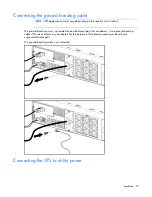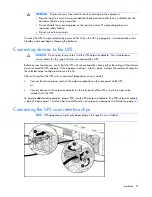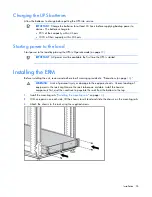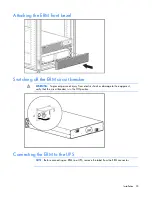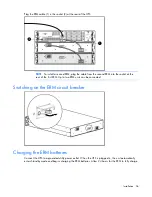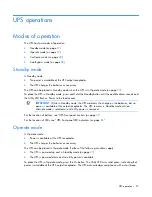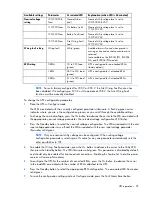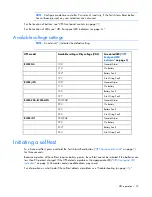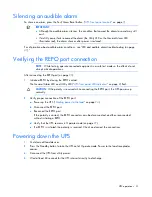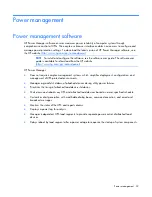
Maintenance 36
WARNING:
To prevent personal injury, prepare the area and observe all materials-handling
procedures when transporting a battery module. Battery modules weigh 20 kg (44.1 lb).
NOTE:
Replace all battery modules at the same time.
Battery care and storage guidelines
•
Minimize the amount of time the UPS uses battery power by matching the UPS configuration with the
utility voltage. Refer to "Configuring the UPS (on page
28
)."
•
Keep the area around the UPS clean and dust-free. If the environment is very dusty, clean the outside
of the UPS regularly with a vacuum cleaner.
•
Maintain the ambient temperature at 25°C (77°F).
•
If storing a UPS for an extended period, recharge the batteries every 6 months:
CAUTION:
Because of the short shelf life of the batteries, avoid storing a battery spare as a
backup. Do not maintain an inventory of spare batteries on site unless a procedure to keep
these batteries charged while in storage is implemented.
a.
Connect the UPS to utility power.
b.
Allow the UPS to remain in Standby mode.
c.
Allow the UPS to charge the batteries for at least 24 hours.
d.
Update the battery recharge date label.
Determining when to replace batteries
When the Battery Fault LED illuminates, batteries might need to be replaced within 30 to 60 days.
When a battery alarm sounds, initiate a UPS battery self-test to verify that battery replacement is required.
If the Battery Fault LED remains illuminated, replace the batteries as soon as possible.
For more information on initiating a self-test, see "Initiating a self-test (on page
30
)."
For the location of LEDs, see "UPS front panel LED indicators (on page
8
)."
Obtaining new batteries
New batteries may be required within 30 to 60 days when the Battery Fault LED illuminates red. Obtain
spare batteries for the UPS when this occurs.
Spare battery modules are supplied for this UPS. The UPS spare battery kit part number is 407407-001.
CAUTION:
Because of the short shelf life of the batteries, avoid storing a battery spare as a
backup. Do not maintain an inventory of spare batteries on site unless a procedure to keep
these batteries charged while in storage is implemented.
UPS battery replacement procedure
This component is hot-swappable and can be replaced without powering down the UPS.

